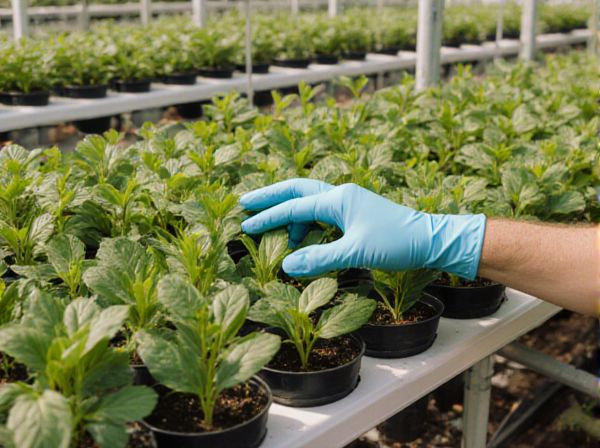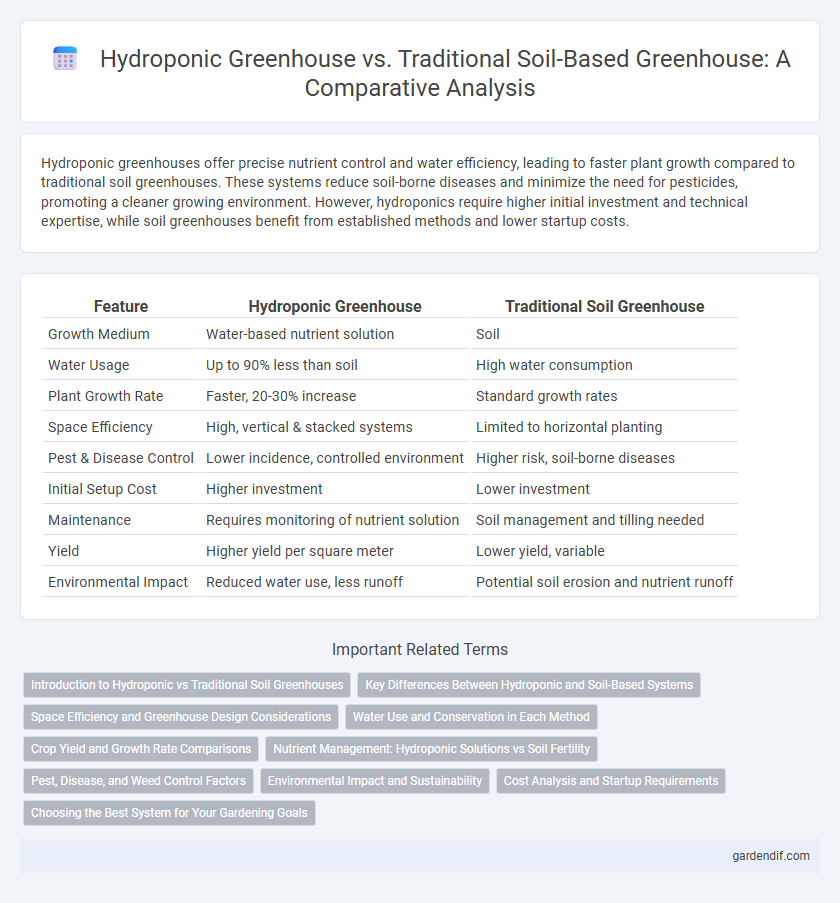
Hydroponic greenhouse vs traditional soil greenhouse Illustration
Hydroponic greenhouses offer precise nutrient control and water efficiency, leading to faster plant growth compared to traditional soil greenhouses. These systems reduce soil-borne diseases and minimize the need for pesticides, promoting a cleaner growing environment. However, hydroponics require higher initial investment and technical expertise, while soil greenhouses benefit from established methods and lower startup costs.
Table of Comparison
| Feature | Hydroponic Greenhouse | Traditional Soil Greenhouse |
|---|---|---|
| Growth Medium | Water-based nutrient solution | Soil |
| Water Usage | Up to 90% less than soil | High water consumption |
| Plant Growth Rate | Faster, 20-30% increase | Standard growth rates |
| Space Efficiency | High, vertical & stacked systems | Limited to horizontal planting |
| Pest & Disease Control | Lower incidence, controlled environment | Higher risk, soil-borne diseases |
| Initial Setup Cost | Higher investment | Lower investment |
| Maintenance | Requires monitoring of nutrient solution | Soil management and tilling needed |
| Yield | Higher yield per square meter | Lower yield, variable |
| Environmental Impact | Reduced water use, less runoff | Potential soil erosion and nutrient runoff |
Introduction to Hydroponic vs Traditional Soil Greenhouses
Hydroponic greenhouses utilize nutrient-rich water solutions to grow plants without soil, offering precise control over nutrient delivery, reduced water usage, and faster plant growth compared to traditional soil greenhouses. Traditional soil greenhouses rely on soil as a growth medium, which can introduce variability in nutrient availability, pests, and diseases, requiring more extensive management. The hydroponic method enhances space efficiency and supports higher yields by optimizing environmental conditions and resource use.
Key Differences Between Hydroponic and Soil-Based Systems
Hydroponic greenhouses utilize nutrient-rich water solutions to grow plants without soil, enabling precise control over nutrient delivery and reducing water usage by up to 90% compared to traditional soil-based systems. Soil-based greenhouses rely on natural soil ecosystems, which can limit nutrient availability but support beneficial microorganisms that enhance plant growth. Hydroponic systems often yield faster plant growth and higher production density, while soil greenhouses tend to be more resilient to system failures and require less technological investment.
Space Efficiency and Greenhouse Design Considerations
Hydroponic greenhouses maximize space efficiency by enabling vertical stacking and denser plant arrangements, unlike traditional soil greenhouses which require more room for soil beds and plant spacing. The design of hydroponic systems incorporates precise nutrient delivery and controlled environments, reducing the need for wide walkways and allowing compact setups. Traditional soil greenhouses emphasize soil quality and irrigation infrastructure, often resulting in larger footprints and less flexible layouts.
Water Use and Conservation in Each Method
Hydroponic greenhouses use up to 90% less water than traditional soil greenhouses by recirculating nutrient solutions and minimizing evaporation. Traditional soil greenhouses often experience significant water loss through runoff and soil absorption, requiring more frequent irrigation. Efficient water use in hydroponic systems supports sustainable agriculture by conserving limited water resources.
Crop Yield and Growth Rate Comparisons
Hydroponic greenhouses consistently achieve higher crop yields compared to traditional soil greenhouses due to precise nutrient delivery and optimized growing conditions. Growth rates in hydroponic systems accelerate by up to 25-50% because plants access essential nutrients directly in the nutrient-rich water solution, reducing growth cycle times. Studies reveal hydroponic methods can produce 30-50% more harvests annually, enhancing productivity and resource efficiency in controlled environments.
Nutrient Management: Hydroponic Solutions vs Soil Fertility
Hydroponic greenhouses offer precise nutrient management by delivering a balanced, water-soluble nutrient solution directly to plant roots, ensuring optimal uptake and minimizing waste. Traditional soil greenhouses rely on soil fertility, where nutrient availability fluctuates due to microbial activity, soil composition, and environmental factors, often requiring frequent soil amendments. Hydroponic systems reduce the risk of nutrient leaching and enable real-time monitoring of nutrient levels, leading to enhanced plant growth and higher yields compared to soil-based cultivation.
Pest, Disease, and Weed Control Factors
Hydroponic greenhouses significantly reduce pest, disease, and weed issues compared to traditional soil greenhouses by eliminating soil-borne pathogens and weeds, resulting in cleaner growing conditions. Controlled environments in hydroponic systems allow for better regulation of humidity and temperature, minimizing pest infestations and fungal diseases. This precision in control decreases the reliance on chemical pesticides, promoting healthier crop growth and reducing environmental impact.
Environmental Impact and Sustainability
Hydroponic greenhouses use up to 90% less water compared to traditional soil greenhouses, significantly reducing resource consumption. These systems minimize soil degradation and prevent chemical runoff, promoting cleaner ecosystems and healthier biodiversity. Energy-efficient climate control in hydroponic greenhouses further lowers carbon emissions, enhancing overall sustainability in agricultural practices.
Cost Analysis and Startup Requirements
Hydroponic greenhouses require higher initial investments due to advanced irrigation systems, nutrient delivery setups, and climate controls, whereas traditional soil greenhouses have lower startup costs primarily for soil preparation and basic structural needs. Operational costs in hydroponic systems tend to be lower over time thanks to efficient water and nutrient use, reducing waste and increasing yield per square meter. Traditional soil greenhouses often incur higher expenses for fertilizers, pesticides, and labor-intensive soil management, impacting long-term profitability and sustainability.
Choosing the Best System for Your Gardening Goals
Hydroponic greenhouses offer precise nutrient control and water efficiency, ideal for maximizing crop yield in limited spaces, while traditional soil greenhouses provide natural buffering and soil biodiversity that benefit long-term plant health. Selecting the best system depends on your gardening goals: hydroponics excels in faster growth and higher productivity, whereas soil-based greenhouses support organic practices and ecosystem balance. Factors such as crop type, space constraints, resource availability, and sustainability priorities should guide the decision between hydroponic and traditional soil greenhouses.
Hydroponic greenhouse vs traditional soil greenhouse Infographic

 gardendif.com
gardendif.com